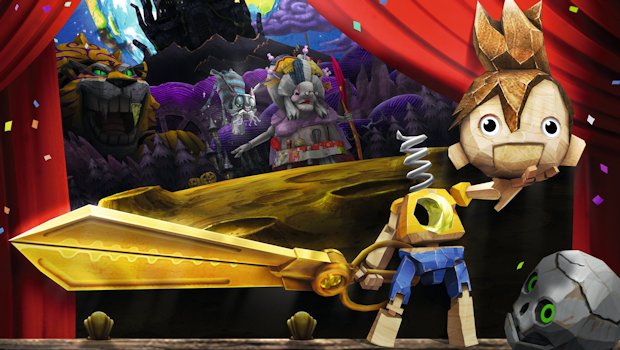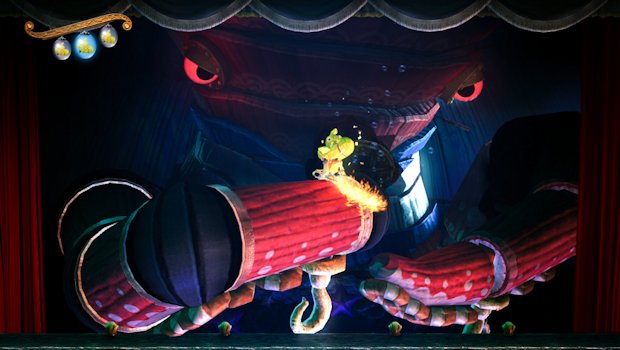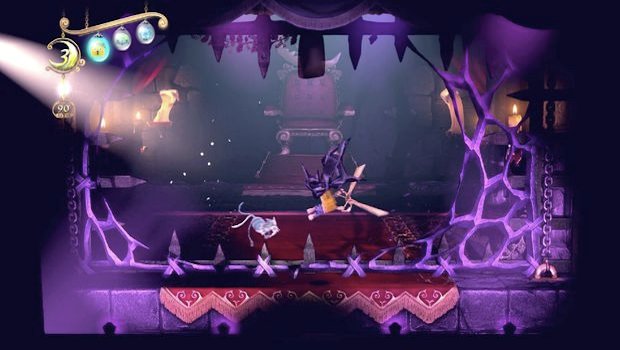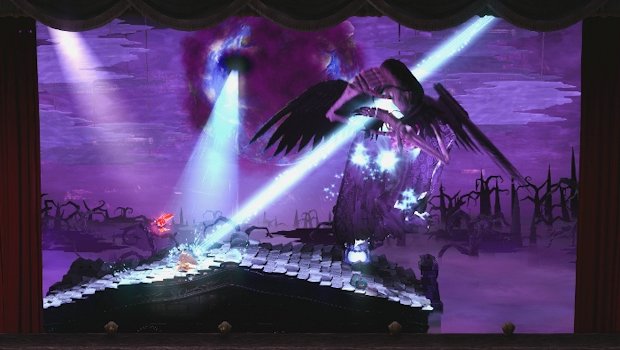There is something to be said about putting your best foot forward. And yet, I fell asleep the first time I played The Puppeteer, the latest title from Sony’s Japan Studios. The intro, though packed with a unique visual style and loads of charm, was thoroughly un-engaging. The game failed to grab me.
But there is also something to be said about making snap judgements after experiencing a thing for just a fraction of what it has to offer. After falling asleep, I made the assumption that The Puppeteer was going to be a bust. It Turns out the game was more of a slow burn that needed to marinate properly before it caught me. The Puppeteer did eventually reel in me and for fans of side-scrolling platformers, you should let it ensnare you too.
Set against the backdrop of a puppet show, The Puppeteer puts players in control of Kutato, a boy whose soul has been kidnapped by the dastardly Moon Bear King. The Moon Bear King snaps Kutaro’s head off, casting aside his body which is where the adventure truly begins. Without a head Kutaro can’t survive for long, and he quickly must attach a new head to his body. With the help of a flying moon cat, Kutaro is once again whole, albeit with a head that isn’t his own, and he must set out to regain his personal top piece and put his soul back together. Along the way, he must take down the evil King and rescue all the lost souls of the children of earth.
The Puppeteer buys wholly into its puppet show presentation and each level is presented as one of three curtains in the seven act show. Levels have an organic look to them, leaning heavily on fabric, paper, and wood textures. And as Kutaro progresses through them, the backgrounds look like they are being moved via a pulley system. There is also a constant narrator giving the audience bits and pieces of story as the show progresses. Speaking of the audience, they applaud, laugh, or gasp appropriately depending on the situation and it really works in selling the puppet show aesthetic.
The aesthetic isn’t just for the purpose of the narrative though, as nearly everything in the game plays off that theme in some aspect of the gameplay. For instance, the narrative conceit of Kutaro needing a head is also the core health mechanic in the game. Getting hit by an enemy, projectile or falling on spikes, will cause Kutaro’s head to pop off. But, if one is fast enough, they may be able to retrieve their head and save their life. Also three heads are better than one: over the course of the adventure Kutaro can bank up to three heads at a time giving players a bit of leeway in regards to taking damage.
More important than collecting heads are the magical golden sheers that Kutaro obtains in the first Act of the game. While a giant narrative construct to push Kutaro on his way in the adventure, they also become the primary weapon for the young hero and a way to move around the world. While The Puppeteer offers plenty of traditional platforming, it is the sheers that make the game something different. Using Calibrus, the name for the magic scissors, Kutaro can cut certain parts of the environment, be they ribbons, leaves, or clouds of smoke, amongst other things, and in doing so he can pull himself along the cut. This allows Kutaro, provided he continues to maintain a constant cut, to fly around the stage allowing for a verticality not present in many platformers.
While the most engaging of all the special powers Kutaro obtains over the course of the game, its not without its problems. Starting a cut is simple but maintaining a cut, especially if the path, as it often does, whips around the screen, can be somewhat difficult due to the looseness of the analog controls. More than once I had to restart a segment because I slipped off the path, resulting in an untimely and frustrating death of my little hero.
Even with the less than precise cutting controls though, the upsides of their implementation give the game a sense of uniqueness that outstrips its faults. This is never more evident than in plethora of boss battles scattered throughout the game. Each one, over 12 in all, requires a different use of one of Kutaro’s powers in combination with the magical cuts of Calibrus. These could very easily have suffered from their cliched engagement loop of figuring out its pattern and landing attacks three times. Because of the different uses of magic cutting in each encounter, the battles always feels fresh and new.
As great as the snipping is though, The Puppeteer is a total package that lives and dies by its intertwined nature of the game mechanics, narrative, and puppet show setting. When it works, which it does more often than not, it is effectively charming and fun. And because it works so well most of the time, when it doesn’t it really stands out. These moments feel unnatural and struck me as the game trying too hard to ramp up the charm. Thankfully these occurrences are rare.
What’s not rare though was the smile I had on my face while playing the majority of The Puppeteer. Outside of the dull opening, the game is a pure joy to play and one that Japan Studio should be quite proud of.
Note: This review was written with material received from the publisher. For more on our review process, please read here.



